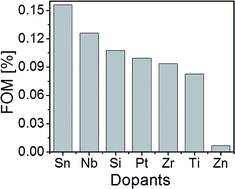Systematic comparison of different dopants in thin film hematite (α-Fe2O3) photoanodes for solar water splitting†
Abstract
Numerous studies have shown that the addition of different impurities as dopants in hematite (α-Fe2O3) photoanodes improves water photo-oxidation. The improvements observed may have resulted from electronic and/or catalytic effects, but also from changes in the layer morphology and microstructure induced by different precursors. The latter could be quite substantial, especially in mesoporous layers produced by chemical routes, making it difficult to make a systematic comparison between different dopants. This work attempts to overcome this difficulty by comparing different dopants in thin films produced by pulsed laser deposition (PLD), a physical deposition method that produces highly reproducible films with no significant variations in the microstructure and morphology. This enables systematic comparison of the effect of different dopants without spurious side effects due to variations in the microstructure and morphology. Thus, we examine the effect of Sn, Nb, Si, Pt, Zr, Ti, Zn, Ni and Mn dopants on the photoelectrochemical properties of thin (∼50 nm) film hematite photoanodes deposited by PLD from Fe2O3 targets doped with ∼1 cation% of the respective dopants onto FTO coated glass substrates. The morphology and microstructure of the films were nearly the same, independent of the different dopants in the films. The Sn-doped hematite photoanode outperformed all the other photoanodes that were examined in this work in both the photocurrent and photovoltage, achieving the highest photocurrent (∼1 mA cm−2) and the lowest onset potential (∼1.1 VRHE). Based on a figure of merit that accounts for the maximum photocurrent × photovoltage product (i.e., power) as well as the potential at which the maximum power is achieved, our photoanodes ranked in the following order: Sn > Nb > Si > Pt > Zr > Ti > Zn > Ni > Mn. These observations are not always consistent with other reports on doped hematite photoanodes, suggesting that the photoelectrochemical properties and performance depend not only on the identity of the dopant but also on the dopant concentration, distribution and the morphology and microstructure of the photoanode in which the dopant is incorporated.

- This article is part of the themed collection: Water splitting and photocatalysis

 Please wait while we load your content...
Please wait while we load your content...